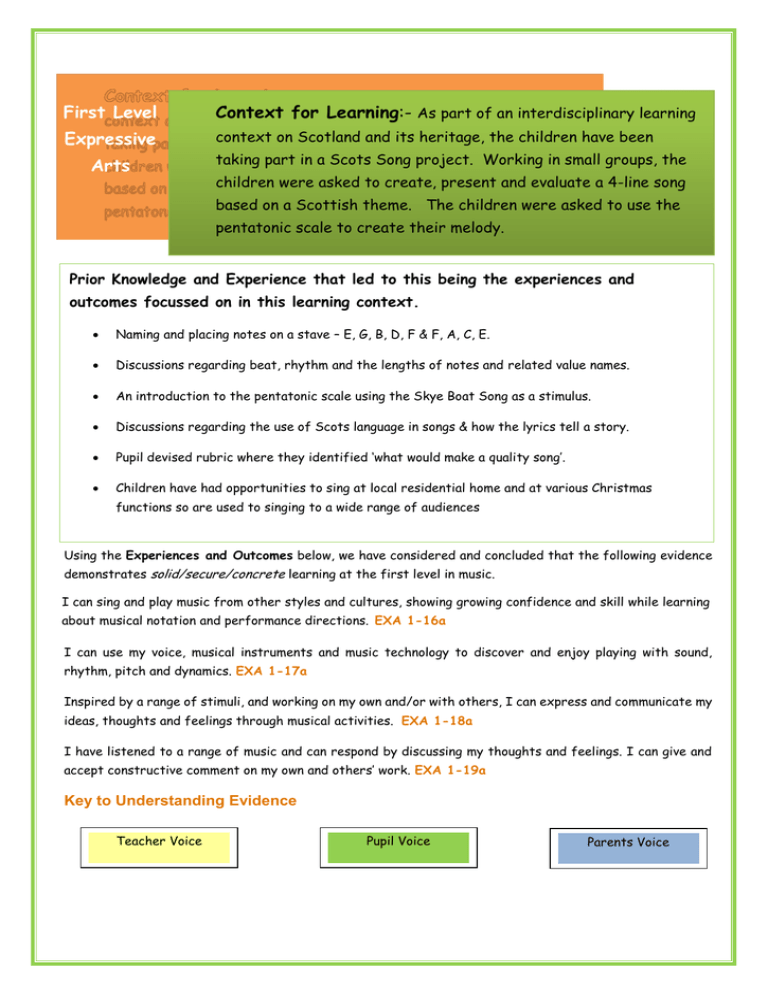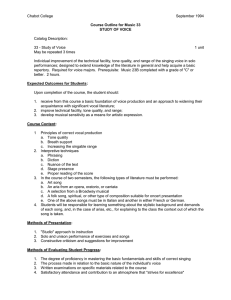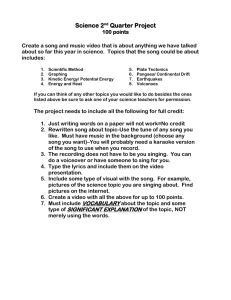Context for Learning First Level Expressive
advertisement

First Level Context for Learning:- As part of an interdisciplinary learning Expressive context on Scotland and its heritage, the children have been Arts taking part in a Scots Song project. Working in small groups, the children were asked to create, present and evaluate a 4-line song based on a Scottish theme. The children were asked to use the pentatonic scale to create their melody. Prior Knowledge and Experience that led to this being the experiences and outcomes focussed on in this learning context. Naming and placing notes on a stave – E, G, B, D, F & F, A, C, E. Discussions regarding beat, rhythm and the lengths of notes and related value names. An introduction to the pentatonic scale using the Skye Boat Song as a stimulus. Discussions regarding the use of Scots language in songs & how the lyrics tell a story. Pupil devised rubric where they identified ‘what would make a quality song’. Children have had opportunities to sing at local residential home and at various Christmas functions so are used to singing to a wide range of audiences Using the Experiences and Outcomes below, we have considered and concluded that the following evidence demonstrates solid/secure/concrete learning at the first level in music. I can sing and play music from other styles and cultures, showing growing confidence and skill while learning about musical notation and performance directions. EXA 1-16a I can use my voice, musical instruments and music technology to discover and enjoy playing with sound, rhythm, pitch and dynamics. EXA 1-17a Inspired by a range of stimuli, and working on my own and/or with others, I can express and communicate my ideas, thoughts and feelings through musical activities. EXA 1-18a I have listened to a range of music and can respond by discussing my thoughts and feelings. I can give and accept constructive comment on my own and others’ work. EXA 1-19a Key to Understanding Evidence Teacher Voice Pupil Voice Parents Voice Learning intentions Children should be able to Compose a short tune using a pitched instrument using a given set of notes. Follow direction and include pitch in a performance in front of a live audience. Reflect on their own and others’ performances identifying strengths and areas for improvement. Our Success Criteria for “A Quality Song” With support the learners created the rubric that identified their success criteria and supported them in identifying next steps in their learning. Creation of the rubric demonstrates in itself a knowledge and understanding of what skills are required in order to work as a team to produce a traditional Scottish piece of music. Mini music-maker Mighty musical Musical maestro Extra wee bits that make it This is the success criteria that we This shows the progression that This column is for learners requiring music-tastic! would expect children to achieve at learners may achieve in second level. additional challenge. first level. With help, I can make up a tune using five notes. With help, I can read basic notes and follow instructions during performance. When asked, I can comment on my own work – what is going well? What is tricky? With a little help, I can make up a tune using five notes and write down the notes on a stave. I can make up a tune using five notes and write down the notes on a stave. With a little help, I can show that I have a basic understanding of the pentatonic scale, rhythm and louds and softs. I can show an understanding of the pentatonic scale, rhythm and dynamics. With a little help, I can read musical notation and follow performance directions. I can read musical notation and follow performance directions independently. With a little help, I can comment on my own work and the work of others – what is going well? What is tricky? Next steps? I can reflect on and accept feedback about my own song and the songs of others, identifying strengths and areas for improvement – www, ebi Learning Activity:- Opportunities for the children to explain what they have learned and how this related to the success criteria in their rubric Evaluating Significant creaCreatCreating Aspect of Evidence:- The learner was able to reflect on his own and others work using the terms what went well (WWW) and even better if (ebi)’”. Evidence:- Children had the opportunity to reflect on their own group’s performance. This demonstrated awareness of what they needed to do, in musical terms, to improve the quality of their song for the listener Learning:- Evidence of Learning in the Evaluating and Appreciating aspect of the “We have completed the tune. We have got quite familiar with the first two lines but we need to look at the ending lines, pull it all together and add a time signature”. Watch video: Improve the quality of the song for the listener “What went well was that we got all of the notes down. We just need to make a few adjustments with the singing because a few people were quite quiet so we need to be more confident.” Expressive Arts This exemplar shows that the child has had opportunities to analyse, explore and reflect In particular in first level music the child: can describe and reflect on the Evidence: - During reflection development of their time the learner discussed with their teacher their progress and own and others’ work achievement in music using the and identify strengths rubric that had been created. and areas for improvement “Before I started this project I didn’t know much about the value of the notes, but I can now apply that skill when I am playing my chanter. It will help me playing my chanter as I will now know not to hold the notes for as long as I want as I was doing before.” Evidence:- Child demonstrates that they can apply what they have learned in other music activities in and out of “I think that I gained learning about dynamics because using different dynamics can school during personal reflection time in school change the sound of your song. I will now use my learning to write my own song”. Next Steps for the Learning:- Children apply their knowledge of what makes a “Quality Song” to provide advice and next steps for children in other classes undertaking a similar project, using the rubric they have already created. Children endeavour to create an additional column in their rubric that would reflect, progression into next level of song writing Learning Activity:- What the children did and what the success criteria was? Presenting creaCreatCreating Evidence:Child 2 demonstrates singing with pitch and following directions regarding dynamics. She also shows awareness of audience by smiling and singing out to project her voice. “Before the performance I had butterflies in my tummy but I got into the flow. At the end of it I felt proud and happy” Learning:- Evidence of Learning in the Presenting Watch video: Singing with pitch aspect of the Expressive Arts Watch video: Singing with a knowledge of dynamics Child 2 demonstrates singing with a good knowledge of dynamics and awareness of audience and clarity of diction required. expressing yourselves.” “I really enjoyed the songs and music they composed”. This exemplar shows that the child can perform and present for different audiences and be a part of an audience for others can demonstrate working Parents’ comments “That was fantastic! Creating songs and music, Significant Aspect of collaboratively as well as learning independently “When we were singing our songs it felt really good to have the whole class singing your own song”. “I loved the music – so inventive. The singing was awesome”. experience enjoyment and contribute to other people’s enjoyment through creative and expressive performances and presentations In particular in first level music the child: perform music (from other styles and Next Steps for the learning:- cultures) demonstrating “When everyone had finished their songs it felt quite strange because we had put so much effort into the project and then we sound, rhythm, pitch thought, ‘what are we doing next?’ But it wasn’t all over because I can apply all of the skills I used into any other musical and dynamics activity I do in and out of the school community”. follow musical notation Learning Activity: The pupils worked in groups to create a piece of Scottish themed music using the pentatonic scale. Creating creaCreatCreating Evidence:- The learner was given an activity that “I found it allowed themFirst to discover pentatonic scale which is Levelthe Expressive Arts interesting a common feature in Scottish music. Using a given that the song score for the Skye Boat Song the learner recorded we are the letters for each note. learning has Evidence of Learning in the only got five Creating aspect of the Expressive notes and it Arts Evidence:- Within a group the learner made many suggestions and built on the ideas of others to produce a brainstorm for their agreed theme ‘bad weathered battle’. Compromising with group members they agreed on the highlighted themes below for their Scottish independence song eg: field, muddy, flags. is called a Significant Aspect of Learning:- pentatonic This exemplar demonstrates that scale”. the child ‘I was really can be creative and express themselves in different ways will be able to express themselves, think innovatively, meet challenges positively and find imaginative solutions to problems can work co-operatively and communicate with others, and in doing, show initiative, dependability , leadership and enterprise surprised when I found out that the Skye Boat Song uses a pentatonic scale’. ‘We have Watch video: Fitting the been rhythm and lyrics together working out tahs and teh tehs for our Evidence:- Pupil clapped out the syllables of the words in their song. words. We have got The rhythm is matched to the number of syllables. The resulting simple four lines notation below, based on tahs and teh tehs is recorded to show the of words rhythm. and almost a time signature. Next we need to do the tune. We also need to think about “We used the different syllables in the words to get our rhythm using tahs and te tehs.” This clip demonstrates how the children fit the rhythm and lyrics of their song together The child opted to remove the keys from the glockenspiel so that he only had the 5 notes in the pentatonic scale present. dynamics.’ The learner recorded the notes they played on the glockenspiel in the correct order using the letters a,c,d,f and g. He knew that these were the only notes in the pentatonic scale. The learner worked in a group to collaboratively agree on the notes that would make their tune. Watch video: Agreeing notes In particular in first level music the child: .“We used a glockenspiel to help us find a tune for the first line of our song. We are only using five notes – C D F G A.” Next Steps for the Learning:- As an individual the pupil will be provided with an opportunity to create another piece of music applying the skills gained so far. can create musical ideas using sounds, rhythm, pitch, dynamics and music technology



